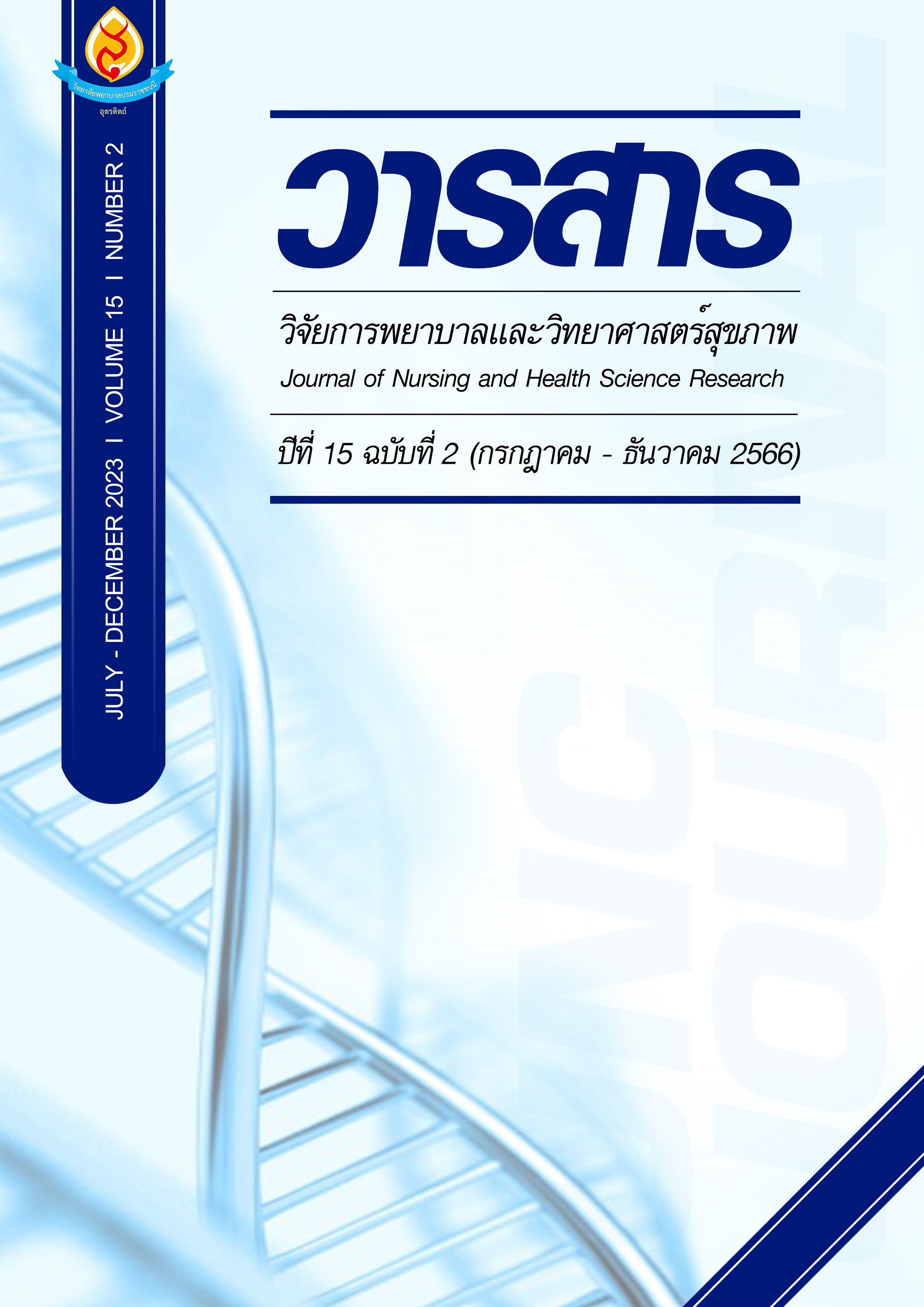การพัฒนาสื่อการเรียนรู้แบบนำตนเองเพื่อป้องกันการคุกคามทางเพศ สำหรับนักศึกษาระดับอุดมศึกษาในจังหวัดลำปาง
Main Article Content
บทคัดย่อ
การศึกษาวิจัยครั้งนี้มีวัตถุประสงค์เพื่อศึกษาปัจจัยที่สัมพันธ์กับการป้องกันการคุกคามทางเพศ พัฒนาและประเมินประสิทธิผลของสื่อการเรียนรู้แบบนำตนเองในการป้องกันการคุกคามทางเพศสำหรับนักศึกษาระดับอุดมศึกษา ศึกษาช่วง ก.ค. 64 ถึง มิ.ย. 65 กลุ่มตัวอย่าง ได้แก่ นักศึกษาระดับอุดมศึกษาในจังหวัดลำปาง จำนวน 443 คน เครื่องมือที่ใช้ ได้แก่ 1) แบบสอบถามปัจจัยที่เกี่ยวข้องกับการรับรู้การคุกคามทางเพศ ผู้วิจัยพัฒนาขึ้น 2) พฤติกรรมการป้องกันตนเองจากการคุกคามทางเพศ ปรับปรุงจากเครื่องมือของ ทิพย์วรรณ แซ่ปัง (Saepung, 2009) และ เฟื่องลดา แผลงศร (Plaengsorn, 2017) 3) สื่อการเรียนรู้แบบนำตนเองในการป้องกันการคุกคามทางเพศแบบออนไลน์ผ่านการตรวจสอบโดยผู้ทรงคุณวุฒิ 3 ท่าน ค่าสัมประสิทธิ์ความตรงของเนื้อหาเท่ากับ .67 – 1 วิเคราะห์ข้อมูลโดยใช้สถิติเชิงพรรณนาและสัมประสิทธิ์สหสัมพันธ์ของเพียร์สัน
ผลการวิจัยพบว่า 1) ปัจจัยการรับรู้การคุกคามทางเพศ, พฤติกรรมการกล้าแสดงออก, ความรู้สึกมีคุณค่าในตนเองและการรู้เท่าทันสื่อออนไลน์ สัมพันธ์กับพฤติกรรมการป้องกันการคุกคามทางเพศ อย่างมีนัยสำคัญทางสถิติที่ระดับ .05 โดยมีค่าสัมประสิทธิ์สหสัมพันธ์อยู่ระหว่าง .158 ถึง .436 2) การเรียนรู้ในการป้องกันด้วยตนเองโดยการใช้การเรียนรู้ทาง Web page ส่งเสริมความรู้เกี่ยวกับพฤติกรรมการป้องกันการถูกคุกคาม เพิ่มความตระหนักรู้ การรู้เท่าทันสื่อออนไลน์ การฝึกทักษะการแสดงออกอย่างเหมาะสมและการฝึกทักษะความรู้สึกมีคุณค่าในตนเอง 3) ผลการเปรียบเทียบพฤติกรรมการป้องกันการคุกคามทางเพศระหว่างก่อนและหลังใช้สื่อการเรียนรู้แบบนำตนเองแตกต่างกันอย่างมีนัยสำคัญที่ระดับ .05 (t=2.085, p-value=.042) โดยค่าเฉลี่ยหลังใช้สื่อการเรียนรู้สูงกว่าก่อนใช้ (𝑥̅= 2.51, SD = .279 และ 𝑥̅= 2.37, SD = .409 ตามลำดับ)
สถาบันการศึกษาระดับอุดมศึกษาควรนำสื่อการเรียนรู้แบบนำตนเองในการป้องกันตนเองจากการคุกคามทางเพศไปประยุกต์ใช้ร่วมกับการเรียนการสอนและกิจกรรมเสริมหลักสูตร
Article Details

อนุญาตภายใต้เงื่อนไข Creative Commons Attribution-NonCommercial-NoDerivatives 4.0 International License.
บทความหรือข้อคิดเห็นใดใดที่ปรากฏในวารสารวิจัยการพยาบาลและวิทยาศาสตร์สุขภาพ เป็นวรรณกรรมของผู้เขียน ซึ่งบรรณาธิการหรือสมาคมศิษย์เก่า ไม่จำเป็นต้องเห็นด้วย และบทความที่ได้รับการตีพิมพ์เผยแพร่ถือเป็นลิขสิทธิ์ของวารสารวิจัยการพยาบาลและวิทยาศาสตร์สุขภาพ
เอกสารอ้างอิง
Anti-corruption Operation Center, Ministry of public health. (2021). Guidelines for preventing and solving problems of harassment or sexual harassment in the work of the Ministry of Public Health. Retrieved from https://dhes.moph.go.th/?p=6639. (in Thai).
Anuphap, K. (2017). Self-directed learning for learning development in computer subject of prathomsuksa 4 students. (Master’s thesis). Dhurakij Pundit University. (in Thai).
Apell, S., Mattunen, S. & Kaltiala, K. (2019). Experiences of sexual harassment are associated with high self-esteem and social anxiety among adolescent. Nordic journal of psychiatry, 73(6), 365-371.
Becton, J. B., Gilstrap, J. B. & Forsyth, M. (2017). Preventing and correcting workplace harassment: Guidelines for employers. Business Horizons, 60(1), 101-111.
Boonchakorn, M. & Singhwee, C. (2020). Assertion, emotional quotient and coping with bullying styles of junior high school students at one of the secondary school in Bangkok metropolis. Journal of Social Sciences and Humanities Research in Asia, 46(1), 146-173. (in Thai).
Chaipet, P. & Chainan, P. (2011). Sexual harassment on social media. CRRU Journal of Communication Chiangrai Rajabhat University, 4(3), 1-38. (in Thai).
Chintanawat, M. (2012). Sexual harassment in the workplace: a case study of the intern's hotel in Bangkok. (Master’s thesis). Silpakorn University. (in Thai).
Data and statistics center of Lampang hospital. (2016). Annual report 2016. Lampang hospital. Retrieved from http://www.lph.go.th/inforlpng/images/report/2559.pdf (in Thai).
Data and statistics center of Lampang hospital. (2019). Annual report 2019. Lampang hospital. Retrieved from http://www.lph.go.th/inforlpng/images/report/2562.pdf (in Thai).
Kheawnamchum, J., Anusasanan, S. & Wongnam, P. (2017). Theoretical models and researches involving causal factors of self - directed learning. Journal of HRintelligence: HRi, 12(1), 125-140. (in Thai).
Khoochonthara, P. (2016). Role of e-learning with self-directed learning. Thammasat University Hospital Journal Online, 1(1), 53-61. (in Thai).
Lampang Provincial Education Office. (2019). Annual report on educational management evelopment educational institutes under Lampang province. Lampang: Office of Education Lampang Province. (in Thai).
McCabe, M. P. & Hardman, L. (2005). Attitudes and perceptions of workers to sexual harassment. The Journal of Social Psychology, 145(6), 719-740.
Niyomrattana, S. (2018). Criminal offenses: The case of sexual harassment. Ramkhamhaeng Law Journal, 7(2), 133-162. (in Thai).
Pakdeemualchon, A. & Rattanasimakul, K. (2017). Factor impacting media-literacy on sex among undergraduate students in Chiang Rai and Chiang Mai. Journal of Management Science Chiangrai Rajabhat University, 12(2), 184 - 204. (in Thai).
Plaengsorn, F. (2017). Perceptions and self-prevention from sexual harassment of female night shift workers. (Master’s thesis). Chulalongkorn University. (in Thai).
Plaengsorn, F. & Perngparn, U. (2015). Sexual threat and self-protection of night shift female workers. Journal of Health Research, 29(2), 245-249. (in Thai).
Prakotwong, N. (2016). Opinion of students about sexual harassment in academy. (Master’s thesis). Thammasat University. (in Thai).
Saenphithak, P., Chaowalit, T. & Kim, Y. (2020). Factors affecting sexual harassment and gender inequality among women in the workplace of South Korea Society. Journal of International Studies, Prince of Songkla University, 10(1), 59-80. (in Thai).
Saiboon, I. M., et al. (2021). Effectiveness of self-directed small-group-learning against self-directed individual-learning using self-instructional-video in performing critical emergency procedures among medical students in Malaysia: a single-blinded randomized controlled study. Clinical Simulation in Nursing, 56, 46-56.
Samoh, N. (2013). Youth perception on cyber bullying. (Master’s thesis). Mahidol University. (in Thai).
Sharma,S. & Agawara, S. (2015). Self esteem and collective self esteem among adolescents: an interventional approach. Psychological thought, 8(1), 105-113.
Sitthiphrai, M. & Pongboriboon. Y. (2021). Development in English language speaking skill of grade 6 student on the topic “We are Friend” through Role- Playing Activity. Journal of MCU Ubon Review, 6(3), 81-92. (in Thai).
Smith, B. L. (2018). What it really takes to stop sexual harassment. Monitor on Psychology, 49(2), 36-40.
Srijan, P., Kaesornsamut, P. & Thanoi, W. (2020). Factors correlated with depression among adolescents in foster homes. Nursing Science Journal of Thailand, 38(1), 86-98. (in Thai).
Stake, J.E., DeVille, C.J. & Pennell, C.L. (1983). The effects of assertive training on the performance self-esteem of adolescent girls. Journal of Youth and Adolescence, 5(12), 435-442.
Suddepongs, T. (2018). Approach to prevent and solve problems of sexual harassment against women at workplace: a case study of electricity generating authority of Thailand. Journal of Social Work, 26(2), 234-250. (in Thai).
Sukkasem, T. (2011). The development of learners' assertiveness behavior by using role- playing methods. (Master’s thesis). Kamphaeng Phet Rajabhat University. (in Thai).
Tamronglak, A. (2009). Sexual harassment in high schools in Bangkok: causes and policy implications. Journal of Burirum Rajabhat University, 1(1), 31-47. (in Thai).
Thipsing, W. & Chalakbang, W. (2020). The strategies for preventing sexual harassment of students in schools under the secondary educational service area offices in the northeast region of Thailand. Journal of Roi Et Rajabhat University, 14(1), 233-245. (in Thai).
Tippratum, C. & Siriwong, P. (2015). Sexual harassment in heterosexual: study for grounded theory. Journal of Humanities and Social Science Valaya Alongkorn, 10(3), 105-113. (in Thai).
Tungpien, N. & Swaengcharoen, K. (2017). The perception on sexual harassment of university students in KhonKaen province. Journal of Nursing and Health, 35(2), 207-215. (in Thai)
Yeamraj, N. (2017). Sexual literacy on online social network of elementary school student. (Master’s thesis). National Institute of Technology Suranaree University of Technology. (in Thai).
Yorn, K. (2017). Development of web - based instruction using self - directed learning to enhance English language skills for secondary 2 students. (Master’s thesis). Rajamangala University of Technology Thanyaburi. (in Thai).


